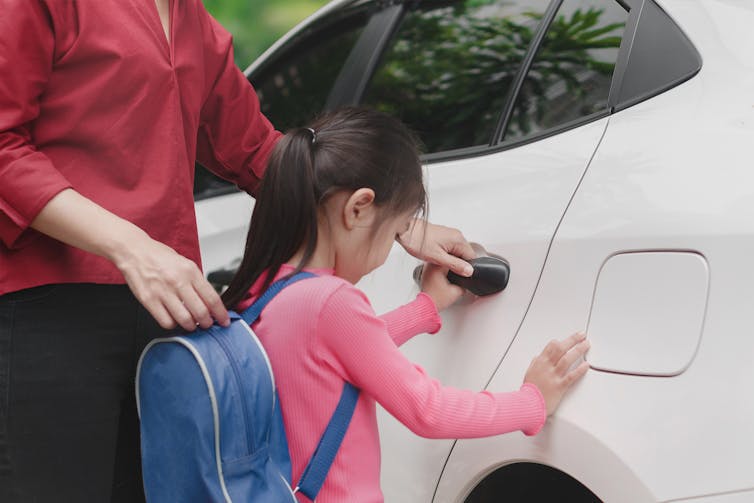Choosing a school for your kid? Here's how other Australian parents do it
- Written by Jen Jackson, Education Policy Lead, Mitchell Institute, Victoria University

School choice is a defining feature of Australian education. One reason is because more families make choices between public and private schools than in other OECD countries.
In 2017, 29.8% of Australian primary, and 40.6% secondary, students were enrolled in private schools, compared to OECD averages of 11.5% (primary) and 17.8% (secondary).
Choices also exist within school sectors, such as selective or alternative government schools, or the variety of religious schools in the independent sector.
Recent research suggests a “generalised state of anxiety” among families that not all schools can be trusted to deliver quality education. This is partly influenced by media reports raising alarm about Australia’s declining education standards.
So with all this choice, and anxiety, how do Australian families decide which school their kids will go to? While convenience and family reasons play a large a part in decision-making at the household level, factors outside the household also influence families’ choices.
School performance
The MySchool website was created to help families make better choices about schools by providing several aspects of school information, the main of which being data about how each school is performing in comparison to others.
School performance is shown using National Assessment Program – Literacy and Numeracy (NAPLAN) results. The theory behind MySchool was that it would motivate schools to strive for better results to attract more families to enrol.
Yet a recent government review found most families aren’t using MySchool for its intended purpose. While 81% of parents agreed information about school performance should be publicly available, this didn’t play a strong part in their choice of a school – only 45% of parents had ever looked at the MySchool website.
Read more: What makes a school good? It's about more than just test results
And 71% of teachers did not believe MySchool influenced families’ choices. The NAPLAN results will now feature less prominently on the MySchool website, in light of the review’s findings.
School performance is still relevant to families’ decisions, however. Parents who don’t use MySchool may use one of a growing number of privately-operated websites to compare prospective schools.
While NAPLAN results may not be persuasive, school ATAR scores can impact on families’ decisions, despite their limitations as a true measure of school performance. Media interest in secondary school results is intense, with The Age newspaper recently releasing its own online interactive school comparison tool.
The best measures of school performance for families to use are those that capture the true value schools add to students’ learning. For example, the measures of student gain on MySchool show how much difference schools are making to students’ learning over time, not just whether they achieve high scores.
Social connections and location
Recent research suggests Australian families choose schools in more complex ways than comparing their results. Choice of school is a strategic exercise, where parents figure out which curriculum subjects offer best advantage for university entry, or which school communities offer the best social connections.
Families with the right social networks are more likely to use “grapevine” methods to choose a school. One teacher in the previously mentioned government review commented that social media beats MySchool “hands down” in shaping families’ decisions.
 Families choose schools based on a number of factors including social connections and location. from shutterstock.com
Families choose schools based on a number of factors including social connections and location. from shutterstock.com
Location also matters in choosing a school, which is as much about the social mix of a particular area as convenience. Moving into an area with desirable schools is the optimal strategy to gain both accessibility and social advantage.
Australian researchers have estimated house prices increase by nearly A$20,000 for every 1% increase in the proportion of top-ranked secondary students in local schools.
Read more: Location matters most to parents when choosing a public school
Schools selecting students
Just as families can select schools, school can also select their students. A growing number of Australian families are opting to seek entry into selective entry government schools.
In NSW – which has more than 45 selective schools – more than 14,000 year 6 students sat the 2018 entry test, competing for just over 4,000 available places.
There is a strong cultural dimension to this choice. Families from language backgrounds other than English constitute 83% of enrolments in NSW selective schools.
As well as the academic environment, selective schools offer families a similar socio-economic mix to a private school, without the price tag. In Victoria and NSW, 59.5% and 74.4% of select-entry school students, respectively, come from the wealthiest quarter of families in the state.
Despite their growing popularity, selective entry schools can incur other costs, such as long commutes (up to 100 kilometres per day), and the stress of entrance tests.
Read more: Selective schools mainly 'select' advantage, so another one won't ease Sydney's growing pains
ANU research has found greater selectivity in education can lower a country’s overall academic performance, and distort students’ concept of their learning ability. This suggests that the choices individual families make to get the best education for their children may have costs for the education system as a whole.
Not all choices (or choosers) are equal
Many Australian families don’t have the opportunity to exercise choice in selecting a school for their child. A 2013 Grattan Institute report found around half of Australian schools had little competition from neighbouring schools, and were essentially the only available local choice.
Even where school options exist, many families cannot act on their preferences due to limited financial, social or academic resources. These families must make their decisions by default, accessing whichever schools are available once more advantaged families have exercised their choices.
The world’s top-performing education systems are those that balance families’ drive to make the best possible choices, with adequate support for those whose access to school choice (and its benefits) is most constrained.
Authors: Jen Jackson, Education Policy Lead, Mitchell Institute, Victoria University





